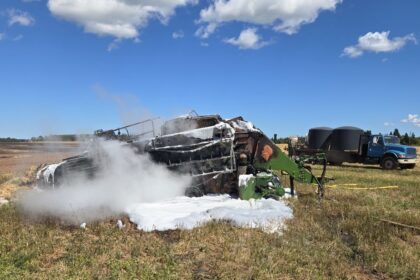Manitoba·NewResidents in a southern Manitoba community have been forced to drive around a washed out road for nearly six months. The hole on Pleasant Valley Road in Rosenort began to form in April, and by May had expanded quickly, according to the deputy reeve for the Rural Municipality of Morris.Hole approximately 6 metres deep, 30 metres long split Pleasant Valley Road in MayNathan Liewicki · CBC News · Posted: Nov 03, 2025 6:00 AM EST | Last Updated: 28 minutes agoListen to this articleEstimated 4 minutesMervin Dueck, deputy reeve of the Rural Municipality of Morris, stands near a washout on Pleasant Valley Road near Rosenort. He estimates the road will cost $1.2 million to repair, and that likely won’t be done until next spring. (Jaison Empson/CBC)Residents in a southern Manitoba community have been forced to drive around a section of road obliterated by a washout for the past six months — and local officials fear the fix won’t be cheap.A gap began to form in April on Pleasant Valley Road near Rosenort, according to Mervin Dueck, deputy reeve for the Rural Municipality of Morris.By May, it had expanded quickly, and is now a chasm roughly six metres deep, nine metres wide close to 30 metres in length, he said.”Essentially, it’s a culvert [under the road] that let go — either rusted or separated — and it creates a cavern underneath, and it just slowly erodes,” said Dueck.WATCH | Road washout raises concerns about safety, travel:Massive washout raises safety, travel worries in southern ManitobaA section of a road near Rosenort, Man., south of Winnipeg, has collapsed into the Morris River after a washout, leaving some residents trying to find workarounds for local access.For some residents in Rosenort — a community of about 800 that’s approximately 50 kilometres south of Winnipeg — the washout has meant longer drives as they bypass the damaged road.It’s frequently used to move farm machinery, and is also used by attendees of a nearby church and people in two residences, which are caught between the Morris River and the municipality’s diversion road.To help the affected residents, the municipality put gravel down on a nearby dike road, which is strictly for their use. Dueck expects that road will need to be used during the winter months, too. Luke Corbett’s property lies adjacent to the washout. His drive to work has been lengthened by a few minutes.”There’s not much you can do about it. No point in getting mad,” Corbett said.He’s more concerned about the safety of others who have bypassed the barricades and approached the edge of the washout since it opened up.Luke Corbett lives adjacent to the washed-out road. He wants it fixed as soon as possible, but says safety is his biggest concern. (Jaison Empson/CBC)”I mean, the drop there is somewhere between 12 and 20 feet. It’s a big drop. There’s a few families that would come by very often, and I would just caution them that things were actively falling in, and we didn’t want anyone getting hurt,” Corbett said.”There were a few times where I had to actually go out and talk to people that were bringing their toddlers and children right up to the edge.”Federal approval needed for repairAnyone close to the washout can see remnants of an old concrete bridge, the broken culvert and whirlpools spinning following a dousing of rain.Work on fixing the road has been slower than some residents would like, but that’s largely because the water source that cut the road in two is the Morris River. Fisheries and Oceans Canada has jurisdiction over any projects tied to that waterway, and any repairs have to be approved by that federal department.”They want fish ladders,” said Deputy Reeve Dueck.”From what we understand right now, they’re putting in bigger culverts, lowering them into the riverbed, and then normally what I think they have done is they’ve put rock in there so that the fish can swim through.”The federal department has approved the project, said Dueck.In a statement to CBC, the department said it will offer the municipality advice on how to protect the fish and their habitat, and how to stabilize the water crossing. It also provided guidance on how to replace the culvert under the Fisheries Act.Pleasant Valley Road has been washed out since May, says the deputy reeve for the rural municipality of Morris. (Jaison Empson/CBC)The municipality has since hired engineers to do an initial assessment on fixing the washout, and Dueck says they’re waiting on the drawings before starting the tender process.”And then we’ve got to find a way to fund it,” he said.He estimates the project will cost $1.2 million, with about $200,000 of it for the culvert alone.”It was a very unexpected issue that we hadn’t budgeted for, so people have to be a bit patient before it gets fixed,” Dueck said.To help ease the pain of taxpayers, Dueck says the municipality will apply for a grant under the Manitoba growth, renewal and opportunities for municipalities, or GRO, program, which funds municipalities up to 50 per cent of total costs for infrastructure projects.If everything goes according to plan, the municipality aims to start the project in March 2026, and hopes to have it done around May, before the high spring waters arrive.ABOUT THE AUTHORNathan Liewicki is an online reporter at CBC Manitoba. He was previously nominated for a national RTDNA Award in digital sports reporting. He worked at several newspapers in sports, including the Brandon Sun, the Regina Leader-Post and the Edmonton Journal.With files from Jim Agapito
Monday, 22 Dec 2025
Canada – The Illusion
Search
Have an existing account?
Sign In
© 2022 Foxiz News Network. Ruby Design Company. All Rights Reserved.
You May also Like
- More News:
- history
- Standing Bear Network
- John Gonzalez
- ᐊᔭᐦᑊ ayahp — It happened
- Creation
- Beneath the Water
- Olympic gold medal
- Jim Thorpe
- type O blood
- the bringer of life
- Raven
- Wás’agi
- NoiseCat
- 'Sugarcane'
- The rivers still sing
- ᑲᓂᐸᐏᐟ ᒪᐢᑿ
- ᐅᑳᐤ okâw — We remember
- ᐊᓂᓈᐯᐃᐧᐣ aninâpêwin — Truth
- This is what it means to be human.
- Nokoma











